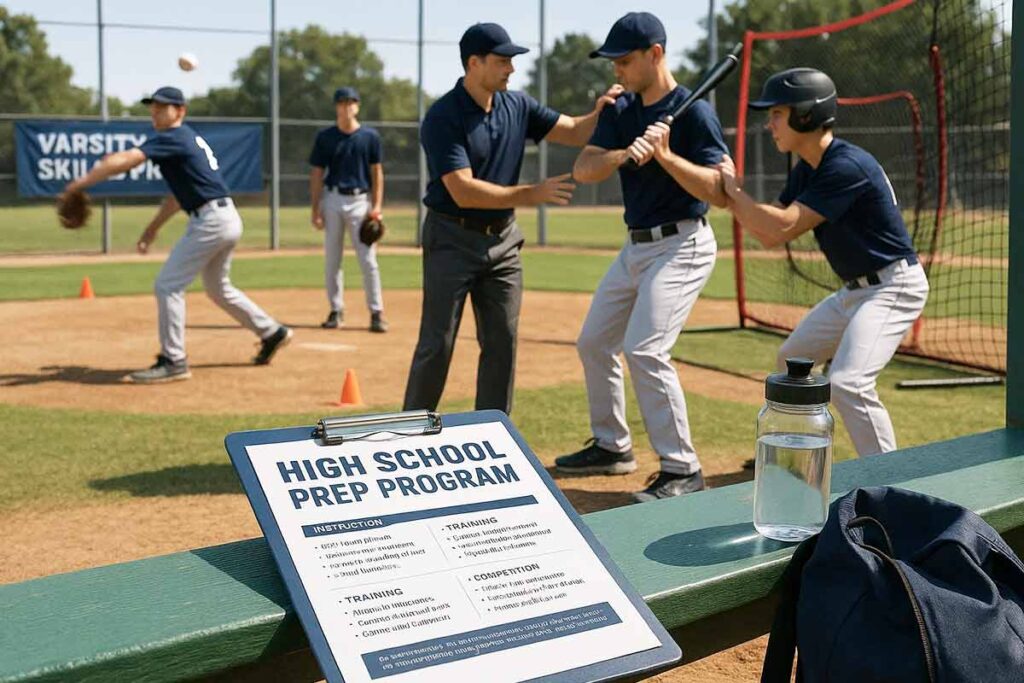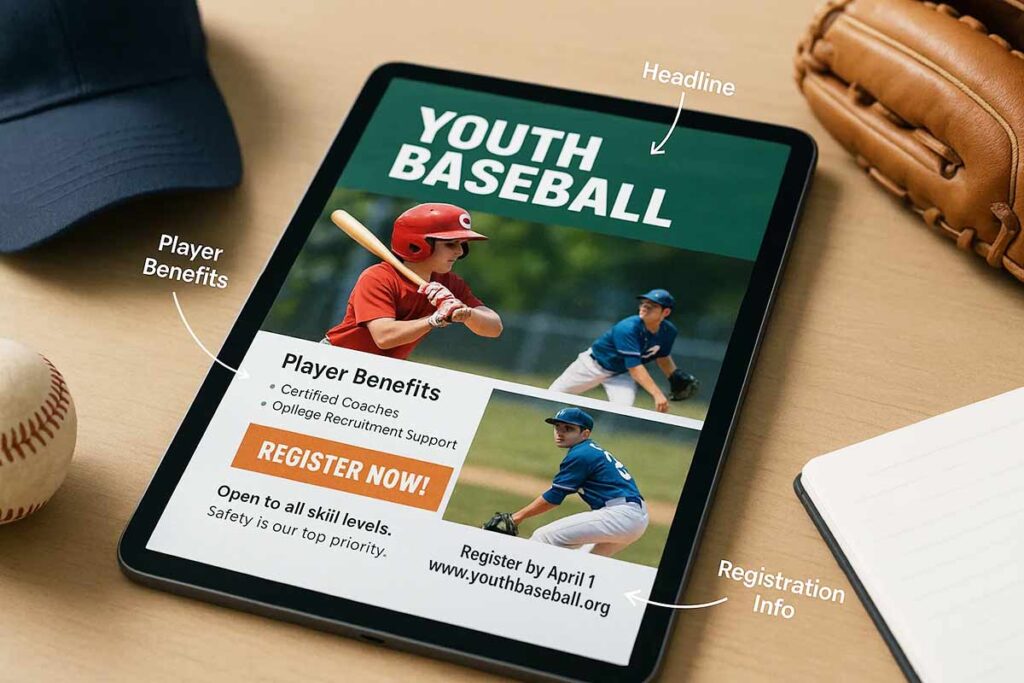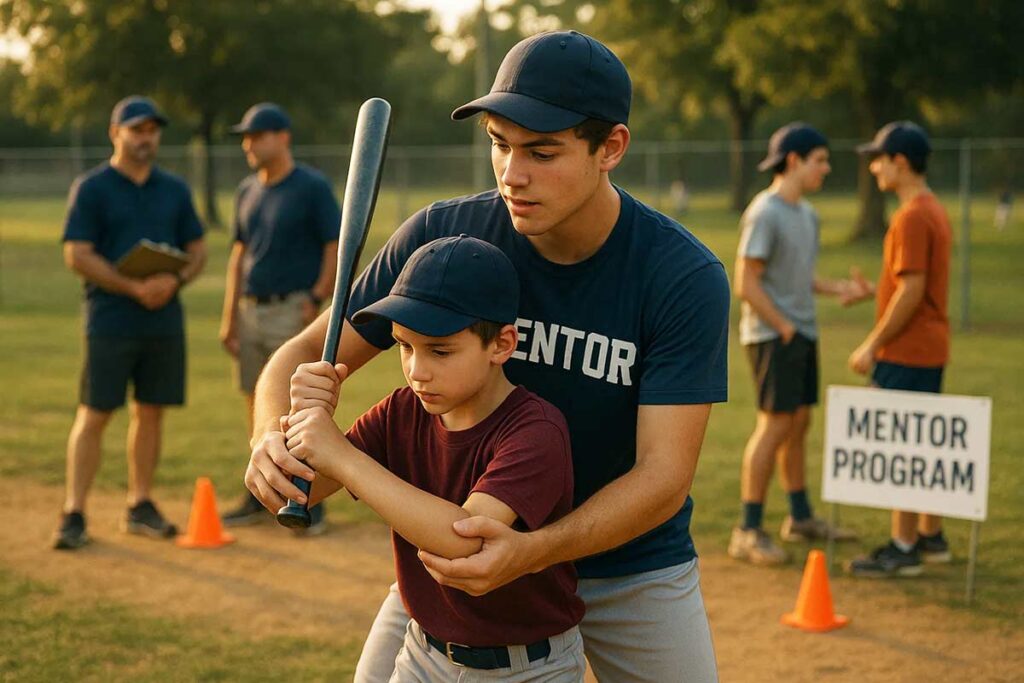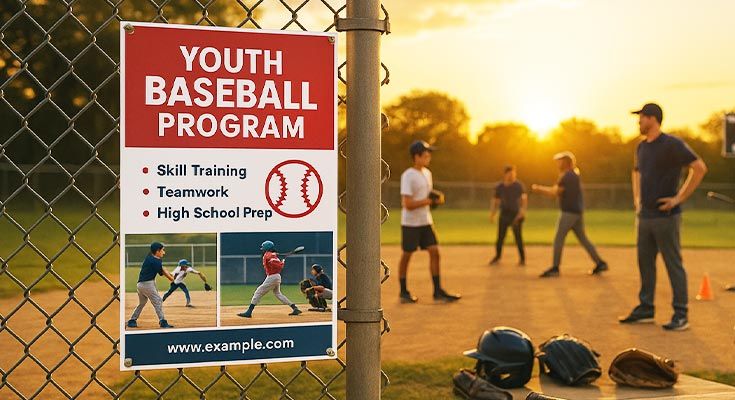Teen baseball programs compete against high school sports, part-time jobs, and social commitments—successful flyers must appeal to both teenage independence and parental support simultaneously. Effective youth baseball flyers for ages 13-18 must balance teenage independence appeal with parental reassurance by emphasizing college recruitment pathways, skill development progression, and flexible scheduling accommodations.
Successful teen program marketing requires understanding dual decision-making dynamics where teenagers influence participation while parents control registration and payment. To effectively reach both audiences, youth baseball program flyers should highlight high school preparation benefits, advanced training methods, and leadership opportunities that set them apart from recreational leagues. Using well-designed baseball flyer templates can help communicate these points clearly while also addressing academic commitment balance and social development needs.
This comprehensive guide examines high school baseball preparation benefits that motivate serious teen athletes, college recruitment pathway communication strategies for competitive positioning, and dual audience messaging techniques balancing teen independence with parental support requirements for maximum program enrollment success.
What High School Baseball Preparation Benefits Should Youth Baseball Program Flyers Emphasize for 13-18 Year Old’s?
High school baseball preparation benefits include advanced skill development, competitive experience exposure, and varsity team readiness that significantly improve teen athletes’ chances of making high school teams. Research published in the Journal of the Society for Social Work and Research demonstrates that school sports participation correlates with improved academic achievement and positive developmental outcomes in middle and high school students.1 Effective youth baseball program flyers must emphasize skill progression pathways, experienced coaching credentials, and success stories of program graduates making varsity teams. Teen-focused marketing requires showcasing measurable development outcomes that differentiate competitive programs from recreational leagues while addressing the specific preparation needs that high school coaches expect from incoming players.

Skill Development Progression: Advanced Training Focus
Advanced skill development focuses on technique refinement that exceeds recreational league instruction through professional-grade training methods. Programs emphasize pitching mechanics improvement using biomechanical analysis, batting stance optimization with video feedback, and defensive positioning strategy that mirrors high school intensity levels. Mental game development includes competitive pressure exposure, strategic thinking advancement, and game situation management that prepares teens for varsity-level decision-making.
Physical conditioning integration addresses teenage athlete development through strength training protocols, agility enhancement programs, and injury prevention strategies designed specifically for growing bodies. Specialized position training allows players to develop expertise in 1-2 positions with intensive instruction that builds college-level competency.
Teen baseball program flyers should highlight coaching credentials including professional playing experience and certified instruction training. To effectively showcase these credentials in a polished and engaging format, an online flyer maker can help create visually appealing flyers that emphasize the program’s advanced training benefits for serious teen athletes. Success metrics such as velocity improvements, batting average increases, and defensive skill advancement provide concrete evidence of program effectiveness that appeals to serious teenage athletes and their parents.
Competitive Experience Exposure: Game Intensity Preparation
Higher competition levels expose teens to faster pitching speeds, advanced defensive strategies, and sophisticated game planning that directly mirrors high school baseball environments. Tournament participation provides essential exposure to college scouts while building performance under pressure capabilities that separate competitive players from recreational participants.
Game intensity preparation includes facing elite pitching, executing complex defensive plays, and managing high-stress situations that develop mental toughness. Programs schedule games against top-tier competition to ensure players experience the speed and strategy they’ll encounter in high school tryouts.
Team chemistry development through advanced teamwork strategies, leadership role distribution, and collaborative decision-making builds essential interpersonal skills. Communication training teaches players to effectively interact with coaches, respond to feedback constructively, and demonstrate coachability that high school coaches value during team selection processes.
Here are a few flyer designs that visually reinforce high-level competition, teamwork, and real-game readiness for motivated athletes
- Dynamic Sports Baseball Tryout Registration Flyer
- Youth Baseball Practice Flyer
- Community Baseball Tournament Event Flyer
Varsity Team Readiness: Specific Preparation Strategies
Varsity team preparation requires understanding high school baseball culture, communication expectations, and performance standards that coaches demand from incoming players. Programs teach proper coach-player relationship building, including respectful communication, feedback reception, and authority recognition necessary for successful high school team integration.
Academic balance integration demonstrates time management skills and commitment levels that high school coaches evaluate during tryouts. Programs emphasize maintaining academic standards while managing athletic responsibilities, showing coaches that players can handle dual commitments effectively.
Position specialization opportunities provide focused skill development in specific roles, strategic knowledge acquisition, and performance consistency that gives teens competitive advantages. Players develop expertise in primary positions while understanding backup role requirements.
Success story integration features specific examples of program graduates making varsity teams, earning starting positions, and receiving recognition. Documentation includes player testimonials, coach recommendations, and achievement tracking that demonstrates program effectiveness. Performance metrics show improvement percentages, skill development timelines, and college recruitment outcomes that validate investment value.
Programs should highlight relationships with local high school coaches, understanding of tryout requirements, and preparation strategies aligned with specific school expectations.
How Do I Communicate College Recruitment Pathway Opportunities in Teen Baseball Program Flyers?
Communicating college recruitment pathways requires showcasing scout exposure opportunities, scholarship preparation assistance, and academic support integration that positions teen athletes for university consideration. Effective youth baseball program flyers emphasize proven track records, recruitment event participation, and comprehensive player development beyond athletic skills. Successful recruitment communication highlights real results. This includes alumni success stories, college placement statistics, and structured development programs. These prepare athletes for university-level competition while maintaining academic standards required for NCAA eligibility.
Scout Exposure Strategy: Visibility and Recognition
Tournament selection participation provides high-visibility events where college scouts actively recruit and evaluate prospective student-athletes. Programs should emphasize showcase event integration offering dedicated platforms for individual skill demonstration and direct college coach interaction opportunities. Video documentation assistance including professional highlight reel creation and performance analysis tools helps college coaches evaluate players efficiently.
Successful programs maintain relationships with college recruiters, ensuring consistent communication about player development and achievement milestones. Statistical tracking systems document individual performance metrics that college coaches require for evaluation decisions. Regional tournament participation increases visibility among university programs seeking specific talent levels and positions.
Programs should highlight specific scout attendance numbers at events, demonstrating legitimate recruitment opportunities rather than empty promises. Direct communication with college coaching staffs creates authentic pathways for exceptional players while maintaining realistic expectations about competition levels and scholarship availability.
These flyer designs demonstrate how to visually communicate college recruitment pathways using success stories, scout exposure stats, and structured development plans
- College Soccer Varsity Team Tryouts Flyer
- Baseball Coaches Wanted Flyer
- Youth Baseball Player Recruitment Flyer
Scholarship Preparation Support: Academic and Athletic Balance
Academic standard maintenance includes GPA monitoring, study hall implementation, and educational priority emphasis meeting NCAA eligibility requirements. The University of Southern California’s Student-Athlete Academic Services emphasizes that student-athletes develop unique transferable skills highly valued by employers, requiring systematic career development planning.2 Athletic performance tracking through statistical analysis, improvement documentation, and achievement recognition demonstrates college-level potential to university recruiters evaluating scholarship candidates.
Character development emphasis includes leadership demonstration, community service integration, and sportsmanship recognition valued by college recruiters seeking well-rounded student-athletes. Programs should provide academic support services including tutoring resources, time management training, and educational planning assistance that enhances overall student success.
SAT and ACT preparation integration helps athletes meet university admission standards while maintaining athletic development focus. College application guidance includes recommendation letter assistance, application timeline management, and interview preparation that supports comprehensive recruitment readiness. Academic achievement recognition alongside athletic accomplishments demonstrates program commitment to educational success.
Comprehensive Development Approach: Beyond Athletic Skills
Life skills integration includes time management training, responsibility development, and independence preparation essential for college success. Communication skills advancement through media interview training, college recruiter interaction preparation, and professional presentation development builds confidence for university environments.
Long-term planning assistance includes college selection guidance, recruitment timeline education, and decision-making support throughout the process. Programs should emphasize character building through community service requirements, leadership opportunities, and mentorship responsibilities that develop well-rounded individuals beyond athletic capabilities.
Financial literacy education helps families understand scholarship types, NCAA regulations, and educational funding options available for student-athletes. Career exploration beyond baseball prepares athletes for professional futures while maintaining competitive focus during high school years.
Success story integration features specific examples of program graduates receiving college scholarships, playing at university levels, and achieving academic success. Alumni networks provide ongoing support and mentorship for current players navigating recruitment processes. Programs should document placement rates, scholarship amounts, and academic achievements demonstrating tangible results for families evaluating program value.
Regular college coach communication maintains relationships that benefit multiple program participants over time, creating sustainable recruitment pathways for serious student-athletes.
Read more: Baseball Tournament Promotion with Flyers
What Competitive Skill Development Progression Makes Youth Baseball Flyers Appealing to Serious Teenage Athletes?
Competitive skill development progression appeals to serious teen athletes through advanced training methodologies, measurable improvement tracking, and elite-level coaching that demonstrates commitment to player advancement. Effective youth baseball program flyers showcase systematic development plans, performance analytics, and individualized training approaches that separate competitive programs from recreational leagues. These programs attract dedicated teenage players seeking professional-level instruction and clear pathways to high school and college baseball success.

Advanced Training Methodologies: Professional-Level Instruction
Biomechanical analysis integration using motion capture technology, swing analysis software, and pitching mechanics optimization with professional-grade equipment elevates training beyond basic instruction. Sport-specific conditioning programs include position-specific training, injury prevention protocols, and performance enhancement strategies designed for teenage athlete development. Mental training integration through sports psychology principles, visualization techniques, and competitive mindset development builds elite performance capabilities.
Advanced programs utilize video analysis, radar gun measurements, and statistical tracking to provide immediate feedback. Strength training protocols focus on baseball-specific movements while preventing overuse injuries common in teenage players. Recovery and nutrition education teaches athletes professional habits essential for sustained improvement. These methodologies prepare serious athletes for high school varsity competition and college recruitment opportunities.
Measurable Improvement Tracking: Data-Driven Development
Performance analytics usage includes statistical tracking, improvement documentation, and benchmark comparison providing concrete evidence of player development. Individual development plans feature personalized goals, skill assessment protocols, and progress monitoring systems ensuring targeted improvement. Regular evaluation processes include skills testing, progress reviews, and adjustment recommendations maintaining development momentum.
Detailed metrics tracking includes batting averages, pitching velocity increases, and fielding percentage improvements over defined periods. Digital portfolios document progress through video comparisons showing technique refinement. Monthly assessments measure advancement against age-group benchmarks and college recruitment standards. Research published in the Journal of Counseling & Development indicates that former NCAA athletes face unique developmental challenges in post-athletic career formation, emphasizing the importance of comprehensive skill development during competitive years.3
Data visualization helps athletes understand improvement patterns and identify areas requiring additional focus. Parent reporting systems provide transparency about investment returns through measurable skill advancement. Success stories feature specific improvement examples demonstrating program effectiveness for serious teenage athletes.
Elite-Level Coaching Standards: Professional Instruction Quality
Coaching credential emphasis includes professional playing experience, certified instruction training, and continued education demonstration ensuring quality instruction. Individualized attention provision through small player-to-coach ratios, personalized feedback delivery, and customized training plan development maximizes individual potential. Advanced strategy instruction includes game situation analysis, tactical decision-making development, and strategic thinking advancement preparing players for higher competition levels.
Professional coaching staff maintains current certifications in sports medicine, youth development, and advanced baseball instruction. Coaches participate in annual training updates and professional development conferences. Many possess college or professional playing experience providing credible instruction authority.
Competition preparation focus includes opponent analysis, strategic planning, and performance optimization teaching players to excel under pressure. Position-specific instruction addresses unique skill requirements for catchers, pitchers, and field players. Mental game coaching develops confidence, focus, and competitive intensity essential for elite performance.
Coaching methodology emphasizes positive reinforcement while maintaining high performance standards. Communication skills training helps coaches connect with teenage personalities while demanding excellence. Parent communication protocols help families understand development goals and timelines. This clarity supports teens aiming for high school varsity and future college recruitment.
Here are some baseball flyer designs that highlight elite coaching credentials, personalized training plans, and player development strategies for competitive athletes
- Youth Baseball Training Camp Flyer
- Baseball Training Camp Event Flyer
- Dynamic Red Sports Baseball Training Camp Flyer
How Can I Address Teenager Independence Needs While Reassuring Parents in Junior Baseball League Flyers?
Addressing teenage independence while reassuring parents requires dual messaging strategies that emphasize player autonomy development alongside comprehensive safety oversight and parental communication systems. Effective youth baseball program flyers present independence opportunities within structured, supervised environments that demonstrate responsible program management. This approach recognizes that teenagers influence participation decisions while parents control registration and payment, requiring content that appeals to both audiences simultaneously.
Structured Supervision Framework: Safety and Oversight
Comprehensive safety protocols include certified coaching staff credentials, medical support availability, and emergency response procedures that ensure player wellbeing throughout all activities. Communication systems feature regular parent updates, progress reports, and concern addressing mechanisms that maintain parental involvement without micromanaging teenage experiences.
Behavioral expectations include respect requirements, responsibility standards, and accountability measures that provide structure within independence development. Adult supervision maintains appropriate ratios, ensures safety compliance, and provides guidance when needed while allowing teenagers space for personal growth and peer interaction.
Clear policy documentation outlines discipline procedures, attendance rules, and performance expectations. These create a predictable environment where teens can safely build independence. Regular staff training ensures consistent supervision quality and appropriate teenage development support throughout program participation.
Independence Development Opportunities: Teen Autonomy Building
Leadership role availability includes team captain positions, mentoring responsibilities, and decision-making opportunities that develop teenage leadership skills naturally. Self-management skill development through equipment responsibility, schedule coordination, and personal goal setting builds independence gradually while maintaining program structure. Player input integration includes team rule participation, strategy discussion inclusion, and feedback provision that respects teenage perspectives without compromising adult supervision.
Programs emphasize individual achievement recognition through performance tracking, skill milestone celebration, and personal improvement documentation that motivates teenage participation. Responsibility assignments include game preparation duties, peer coaching assistance, and program promotion activities. Through these roles, teenagers build accountability while also demonstrating that coaches trust their capabilities. As a result, these opportunities create ownership feelings that satisfy independence needs yet still operate within appropriate boundaries established by adult leadership.
Here are some youth baseball flyer designs ideal for promoting structured programs that support teenage independence through leadership roles and personal growth, while also reassuring parents with clear safety protocols, certified coaching, and ongoing communication.
Parent Partnership Approach: Collaborative Support System
Regular communication schedules include progress updates, behavior reports, and achievement recognition that keeps parents informed without interfering with teenage autonomy development. Volunteer opportunity integration allows parents to contribute meaningfully while respecting teenage independence needs and social dynamics that are crucial during adolescent development.
Educational resources provision includes parenting teenage athletes guidance, college preparation information, and development milestone education that supports family decisions and understanding of teenage athlete needs. Transparency commitment includes program policy access, coaching philosophy explanation, and decision-making process communication that builds parental trust in program management.
Parent consultation availability includes individual meetings, concern-addressing sessions, and family support. These efforts help maintain strong relationships while also encouraging teenage growth. At the same time, clear boundary establishment between parent involvement and player independence ensures healthy development. Moreover, this approach addresses parental concerns about safety and progress without compromising teen autonomy.
Open communication policies allow parents to express concerns while maintaining teenager privacy and autonomy appropriate for their developmental stage. This collaborative approach ensures program success while building family confidence in teenage independence development within supervised athletic environments.
What Scheduling Flexibility Accommodates Teen Academic and Social Commitments in Youth Baseball Program Marketing?
Scheduling flexibility accommodating teen commitments includes multiple practice options, academic priority policies, and social event consideration that recognizes teenage lifestyle complexity. Effective programs offer alternative participation formats, makeup opportunities, and academic support that demonstrate understanding of teenage priorities and responsibilities. Youth baseball program flyers must communicate these flexible scheduling options to appeal to both student-athletes managing demanding schedules and parents concerned about academic balance.
Multiple Practice Option Availability: Schedule Accommodation
Alternative time slots including early morning, evening, and weekend options accommodate varying school schedules and academic commitments. Programs offer 6:00 AM pre-school practices, 7:00 PM weeknight sessions, and intensive weekend training blocks that work around academic calendars.
Seasonal flexibility provides modified participation during exam periods, standardized testing weeks, and academic intensive periods that prioritize education. Programs implement “academic weeks” with reduced practice frequency during finals, SAT testing periods, and college application deadlines. Individual scheduling consultation offers personalized participation plans respecting family priorities and commitments.
Makeup session availability ensures skill development continuity when teens miss regular practices for legitimate academic reasons. Programs provide one-on-one coaching sessions, skills clinics, and video review meetings that maintain development momentum without compromising educational priorities.
Academic Priority Integration: Educational Support
Homework accommodation policies include study time protection, academic deadline respect, and educational goal support demonstrating commitment to student success. Programs implement “homework first” policies where academic responsibilities supersede optional training activities.

Tutoring resource provision includes academic support access, study skill development, and educational planning assistance enhancing student-athlete success. Programs partner with certified tutors, provide quiet study spaces during travel, and implement mandatory study halls for players maintaining below 3.0 GPAs.
Grade monitoring systems include academic progress tracking, support interventions, and achievement recognition, all of which help maintain educational standards. In addition, coaches receive monthly grade reports, coordinate with school counselors, and adjust training intensity based on academic performance. Furthermore, players who earn honor roll recognition receive program scholarships as well as leadership opportunities.
Here are some youth baseball flyer designs ideal for promoting training academies and seasonal camps that can be adapted to feature academic support messaging, grade tracking highlights, and a student-first development philosophy.
- Spring Baseball Academy Camp Flyer
- Dynamic Baseball and Softball Training Lessons Sports Flyer
- Youth Baseball Practice Flyer
Social Development Recognition: Peer Relationship Balance
Social event consideration includes special occasion accommodation, peer activity recognition, and relationship building support acknowledging teenage social needs. Programs excuse players for homecoming events, allow modified schedules during prom season, and support healthy peer relationships outside baseball. Teen baseball program flyer materials emphasize social development alongside athletic achievement.
Team social integration provides organized team building, peer bonding activities, and friendship development opportunities enhancing program experience. Programs schedule team dinners, group community service projects, and recreational outings building camaraderie beyond competitive play.
Community involvement opportunities include service projects, local event participation, and civic engagement building character while accommodating social development.
Family time protection includes holiday respect, family vacation accommodation, and special event recognition maintaining healthy family relationships. Programs implement blackout periods during major holidays, offer flexible summer scheduling around family trips, and encourage family attendance at games.
Programs creating dating policy guidelines, friendship boundary respect, and social pressure management help teenagers navigate complex social dynamics while maintaining athletic commitments.
How Do I Showcase Advanced Training Methods and Facilities in Youth Baseball Academy Flyers?
Showcasing advanced training methods requires highlighting cutting-edge equipment, professional-grade facilities, and innovative instruction techniques that demonstrate program superiority over recreational leagues. Effective facility presentation emphasizes technology integration, safety standards, and performance enhancement capabilities that justify premium program investment for serious teenage athletes seeking competitive development opportunities.
Cutting-Edge Equipment Integration: Technology Advancement
Performance analysis technology including radar guns, video analysis systems, and biomechanical assessment tools provides professional-level evaluation capabilities that separate advanced programs from basic instruction. Training equipment sophistication featuring HitTrax systems, automated pitching machines, and force plate analysis demonstrates commitment to data-driven development. Safety equipment standards including advanced protective gear, emergency medical supplies, and facility monitoring systems ensure player wellbeing during intensive training.
Highlight specific technology brands and capabilities: “Trackman radar analysis tracks exit velocity and launch angle” creates concrete value perception. Include performance improvement statistics: “Average velocity increase of 4.2 mph in first season” provides measurable outcomes. Technology integration appeals to both teenage athletes seeking advanced training and parents evaluating program quality against recreational alternatives.
Document equipment specifications and training applications through visual demonstrations showing actual usage during instruction sessions. Teen baseball program design strategies offers comprehensive equipment presentation techniques.
Professional-Grade Facility Standards: Quality Infrastructure
Field condition excellence including professional maintenance standards, optimal playing surfaces, and regulation specification compliance provides superior training environments that mirror high school and college facilities. Indoor facility capabilities featuring climate-controlled training spaces, batting tunnels, and year-round availability maximize development opportunities regardless of weather conditions.
Support facility integration including modern locker rooms, video analysis rooms, and parent viewing areas enhances overall program experience while demonstrating professional commitment. Facility lighting, drainage systems, and field dimensions meeting regulation standards show attention to quality details that impact player development.
Present facility specifications through professional photography highlighting unique features and quality construction. Include facility comparison charts showing advantages over competitors: “Only facility with indoor batting cages within 20 miles” establishes competitive positioning. Maintenance schedules and quality standards communicate ongoing investment in player experience.
Here are the baseball specific flyers offer ideal layouts for showcasing academy structure, performance tracking, coaching credentials, and facility quality—helping you communicate professionalism and impact to both athlete families and teen recruits.
- Team Baseball Roster Announcement Flyer
- Baseball Season Tournament Event Flyer
- Baseball Game Final Score Flyer
Innovative Instruction Methodology: Advanced Teaching Approaches
Specialized coaching techniques including biomechanical analysis, position-specific instruction, and individualized development plans maximize player potential through systematic skill advancement. Technology-enhanced instruction through video analysis integration, performance tracking systems, and data-driven coaching methods optimize training effectiveness beyond traditional approaches.
Comprehensive development programs addressing strength training, mental conditioning, and nutritional guidance cover all performance aspects while injury prevention protocols ensure safe advancement. Small coach-to-player ratios enable personalized attention and customized instruction that accelerates skill development.
Advanced training periodization includes off-season conditioning, in-season skill refinement, and recovery protocols that professional athletes use. Mental training integration through sports psychology principles, visualization techniques, and competitive mindset development prepares players for high-pressure situations.
Coaching credential emphasis including professional playing experience, certified instruction training, and continuing education demonstrates instruction quality. Success tracking through statistical analysis, improvement documentation, and college placement records provides concrete evidence of program effectiveness.
Present methodology through before-and-after player development examples showing measurable improvement. Include coaching philosophy statements and training principles that differentiate your approach. youth baseball flyer templates provides facility showcase design options for comprehensive program presentation.
What Leadership and Mentorship Opportunities Differentiate Teen Baseball Programs From Youth Leagues?
Leadership and mentorship opportunities differentiating teen programs include player development roles, peer teaching responsibilities, and community service integration that builds character beyond athletic skills. Advanced programs offer leadership training, mentorship structures, and responsibility assignments that prepare teenagers for adult roles while developing essential life skills through sports participation. Youth baseball program flyers effectively communicate these character-building opportunities to attract families seeking comprehensive development programs that extend beyond recreational leagues.
Player Development Role Assignment: Leadership Skill Building
Teen programs assign meaningful leadership responsibilities including team captain positions that require communication skills, conflict resolution abilities, and team morale maintenance during challenging situations. To promote these leadership opportunities effectively, flyer templates can help create professional baseball program flyer that highlight the character-building aspects of the program for both teens and parents. Experienced players mentor newcomers through peer coaching opportunities, sharing technical knowledge while developing teaching capabilities that benefit both participants. These programs create administrative assistant roles involving equipment management, event organization, and program promotion that build organizational skills essential for future success.
Leadership development extends beyond sports through decision-making responsibilities, strategic planning participation, and accountability measures that prepare teenagers for adult workplace dynamics. Programs emphasize responsibility building through graduated leadership assignments, allowing teens to demonstrate competence before receiving increased authority levels.
Mentorship Structure Implementation: Guidance and Support
Structured mentorship programs pair experienced athletes with newer participants, creating supportive relationships that enhance skill development while building interpersonal communication abilities. Adult mentors including community leaders, former players, and professional athletes provide guidance extending beyond coaching staff, offering career advice and life perspective that influences long-term decision-making.
Teen baseball program flyers showcase mentorship benefits through success stories and relationship-building examples that demonstrate program value. Life skills instruction includes character development programs, ethical decision-making guidance, and value system reinforcement preparing teenagers for adult responsibilities and challenges.

Programs implement regular mentoring sessions, goal-setting workshops, and progress evaluation meetings that ensure meaningful relationship development between mentors and participants.
Read more: Baseball Tryout Flyers: Complete Player Selection & Evaluation Process Guide
Community Service Integration: Character Development Beyond Sports
Community service leadership opportunities allow teenagers to organize, implement, and evaluate assistance programs that build empathy, civic responsibility, and project management capabilities. Service project coordination develops organizational skills through fundraising leadership, volunteer management, and community partnership development that demonstrates social responsibility beyond athletic achievement.
Youth program assistance provides mentoring experience through helping younger players with instruction, event support, and program promotion activities that build teaching skills and community connection. These opportunities create meaningful engagement with local organizations while developing leadership capabilities that transfer to academic and professional environments.
Charitable activity coordination teaches project planning, team building, and resource management through real-world application rather than theoretical instruction. Recognition programs including leadership awards, service acknowledgment, and achievement celebration reinforce positive behavior while motivating continued character development.
Programs integrate service requirements with flexible scheduling, allowing teens to contribute meaningfully while maintaining academic priorities and athletic commitments. Community partnerships provide ongoing opportunities for leadership development through established relationships with local organizations requiring youth volunteer support.
These comprehensive leadership and mentorship opportunities distinguish competitive teen programs from recreational youth leagues by emphasizing character development alongside athletic skill advancement.
How Can I Optimize Youth Baseball Flyers for Teenage Decision-makers Versus Parent-controlled Registration?
Optimizing youth baseball program flyers for dual decision-makers requires layered messaging strategies that simultaneously appeal to teenage interests while providing parental information needs. Effective design uses visual elements attracting teens alongside detailed information reassuring parents about program quality, safety, and value. Successful flyers balance teen independence appeal with comprehensive program details that address parental concerns about coaching qualifications, facility standards, and development outcomes.
Dual Audience Messaging Strategy: Balanced Communication
Visual hierarchy design places exciting elements prominently for teen attention while ensuring essential information accessibility for parent evaluation. Language tone balance uses energetic, motivational messaging for teens alongside professional, informative content for parental decision-making support. Information layering provides immediate teen appeal through visuals and headlines while offering detailed program information for thorough parental evaluation.
Create separate visual zones targeting each audience: dynamic action photos and achievement highlights capture teenage attention, while coaching credentials, safety protocols, and development metrics reassure parents. Use contrasting fonts where bold, modern typography appeals to teens and clean, readable text ensures parent information accessibility.
Implement dual-track information flow where teens scan for exciting opportunities while parents locate practical details about schedules, costs, and program structure. This approach ensures both decision-makers find relevant information without overwhelming either audience with inappropriate content depth or presentation style.
Here are some youth baseball flyer designs ideal for promoting seasonal programs, training sessions, and tryouts. Also, each layout supports both attention-grabbing headlines for teens and structured info for parents from academic balance to player development:
- Youth Baseball Tryouts Registration Flyer
- Youth Baseball Registration Event Flyer
- Youth Baseball Sign-Up Registration Flyer
Teen Appeal Integration: Interest and Motivation
Peer influence recognition includes team social aspects, friendship development opportunities, and belonging emphasis that appeals to teenage social needs. Achievement focus highlights individual accomplishment potential, recognition opportunities, and skill development that motivates teenage participation. Independence emphasis showcases personal growth opportunities, responsibility development, and self-improvement potential that appeals to teenage development needs.
Feature real teen success stories with specific achievements: “Jake improved batting average from .250 to .380” or “Sarah earned varsity starting position after program completion.” Include social elements like team bonding activities, peer mentorship roles, and leadership opportunities that address teenage social development needs.
Emphasize competitive aspects and advanced training methods that differentiate programs from recreational leagues. Using baseball flyer templates can help highlight these competitive advantages with dynamic designs tailored for teen athletes. Highlight college recruitment pathways, skill progression tracking, and performance analytics that appeal to serious teenage athletes seeking development advancement and recognition opportunities.
Parental Information Requirements: Decision Support
Safety assurance provision includes coaching qualifications, facility standards, and emergency protocols that address primary parental concerns. Value demonstration through cost justification, program comparison advantages, and long-term benefit explanation supports financial decision-making. Communication commitment includes progress reporting, concern addressing, and parent involvement opportunities that build confidence and trust.
Present comprehensive program details including coach backgrounds, certification levels, and experience credentials. Include facility safety features, equipment quality standards, and medical support availability. Provide clear cost breakdowns with payment options, scholarship availability, and value comparison against competing programs.
Establish transparent communication systems through regular progress updates, scheduled parent meetings, and accessible feedback channels. Detail academic support policies including study time protection, grade monitoring, and educational priority emphasis that reassures parents about balanced development.
Include testimonials from other parents highlighting program benefits, safety record, and positive outcomes. Provide specific success metrics including college placement rates, scholarship recipients, and skill improvement statistics that demonstrate program effectiveness and return on investment for concerned parents evaluating program quality and development potential.
Read more: Little League Baseball Flyers: Complete Youth Program Marketing Guide
People Also Ask: Youth Program Implementation Questions
- What flyer format appeals to teenage baseball players for program marketing?
Social media-friendly square formats and visually dynamic designs with bold graphics, action photography, and minimal text appeal most to teenage audiences while maintaining essential information. - What colors and design elements motivate 13-18 year old baseball player interest?
Bold, energetic colors like electric blue, vibrant red, and neon accents combined with modern typography and action imagery create maximum appeal for teenage athletes. - Should youth program flyers use social media-friendly square formats?
Square formats work excellently for Instagram and social sharing while portrait layouts provide better space for detailed program information and parent requirements. - What typography style appeals to both teenagers and their parents?
Modern sans-serif fonts in bold weights for headlines attract teens while clean, readable body text ensures parent information accessibility and professional appearance. - How much program detail do teen athletes want before losing interest?
Teenagers prefer quick-scan information with bullet points, visual elements, and key benefits highlighted, while detailed information should be easily accessible but not prominent. - What digital sharing formats help teens promote programs to friends?
Social media-optimized graphics, shareable story templates, and mobile-friendly formats encourage peer sharing and word-of-mouth program promotion among teenage networks.
Frequently Asked Questions: Teen Program Implementation
- What age range separates youth baseball programs from Little League (13-18 vs 4-12)?
Youth baseball programs target teenagers ages 13-18 who have outgrown Little League’s 4-12 age focus. Teen programs emphasize high school preparation, college recruitment pathways, and independence development while Little League focuses on fundamental skill introduction, parent involvement, and recreational participation. Age separation ensures appropriate instruction, competition level, and social development matching teenage needs and capabilities. - How do teen baseball programs prepare players for high school varsity team competition?
Teen programs prepare players through advanced skill instruction, competitive game experience, and mental toughness development. Programs feature faster pitching, sophisticated strategies, and performance pressure simulation that mirrors high school intensity. Coaching emphasizes position specialization, strategic thinking, and teamwork skills essential for varsity success while building physical conditioning and technical proficiency required for high school competition. - What time commitment balances youth baseball with homework and part-time jobs?
Effective teen programs offer flexible scheduling including multiple practice options, academic priority policies, and seasonal adjustments. Typical commitments include 2-3 practices weekly during school season, weekend games, and intensive summer training. Programs accommodate exam periods, academic deadlines, and part-time work schedules while maintaining skill development momentum through efficient training methods and individual development planning. - Should youth program flyers mention GPA requirements for continued participation?
Academic standards communication helps establish program priorities and attracts serious student-athletes. Many programs require minimum 2.5-3.0 GPA maintenance with academic support provision including tutoring resources and study time protection. Academic requirements demonstrate program commitment to student success while ensuring college recruitment pathway viability and scholarship opportunity preparation for participating athletes. - What transportation independence do teens need for youth baseball program participation?
Teen programs typically require greater transportation independence than Little League including ability to arrive at practices independently, manage equipment transportation, and handle schedule coordination. Programs should communicate transportation expectations clearly while providing carpooling coordination and emergency transportation assistance. Independence requirements vary by location and family circumstances requiring program flexibility and parent communication. - How do youth baseball programs facilitate college scout exposure and recruitment?
Programs facilitate recruitment through showcase tournament participation, college coach relationships, and video documentation assistance. Effective programs maintain scout contact databases, schedule high-visibility events, and provide performance statistics documentation. Recruitment support includes highlight reel creation, college communication guidance, and scholarship application assistance while maintaining realistic expectations about college baseball opportunities. - What position specialization occurs in competitive youth baseball development programs?
Teen programs emphasize position-specific skill development including pitching mechanics refinement, catching techniques advancement, and infield/outfield specialization. Players typically focus on 1-2 positions with intensive instruction in position-specific skills, strategy, and responsibilities. Specialization includes mental game development, situational awareness training, and advanced technique instruction preparing players for high school team roles. - Should teen baseball program flyers include scholarship and financial aid information?
Scholarship information helps parents understand long-term program value while setting realistic expectations. Flyers should include success stories, college placement statistics, and academic support emphasis without guaranteeing scholarship opportunities. Financial aid discussion includes program cost justification, payment plan availability, and scholarship program existence while emphasizing academic achievement importance in college recruitment. - What leadership roles help teenage players develop beyond just baseball skills?
Leadership opportunities include team captain positions, peer mentoring responsibilities, and community service coordination. Teen programs offer coaching assistance roles, equipment management, and event organization that build responsibility and organizational skills. Leadership development includes conflict resolution training, communication skill building, and decision-making experience that prepares teenagers for adult responsibilities beyond athletic participation. - How do youth programs accommodate different skill levels within the 13-18 age range?
Multi-level instruction accommodates varying abilities through skill-based grouping, individualized development plans, and flexible participation options. Programs typically offer recreational, competitive, and elite tracks with appropriate instruction intensity and competition level. Age-appropriate development recognizes physical maturation differences while ensuring challenging instruction for advanced players and supportive environment for developing athletes.
Conclusion: Teen Baseball Program Success Framework
Creating effective youth baseball program flyers for teens requires balancing teen-focused energy with parent-focused information. Flyers should use dynamic visuals and highlight peer engagement, leadership opportunities, and high school preparation to capture teen interest. At the same time, they must reassure parents with details on safety protocols, coaching credentials, academic support, and communication plans. This dual-audience messaging ensures both influence and decision-making roles are addressed.
Programs that emphasize academic integration—like GPA requirements, tutoring access, and schedule flexibility—show a commitment to student-athlete success beyond the field. Leadership development opportunities, such as mentoring younger players or organizing community service, build character and responsibility. This well-rounded approach positions the program as a complete development pathway. To maximize impact, use professionally designed flyer templates that visually reflect your program’s value while effectively converting interest into participation.
Reference:
- School sports participation and academic achievement in middle and high school. Journal of the Society for Social Work and Research.
- Career Development – Student-Athlete Academic Services. Retrieved from University of Southern California.
- Post‐athletic career profiles in adulthood: Identity formation and well‐being of former NCAA Division I and II intercollegiate athletes. Journal of Counseling & Development,



